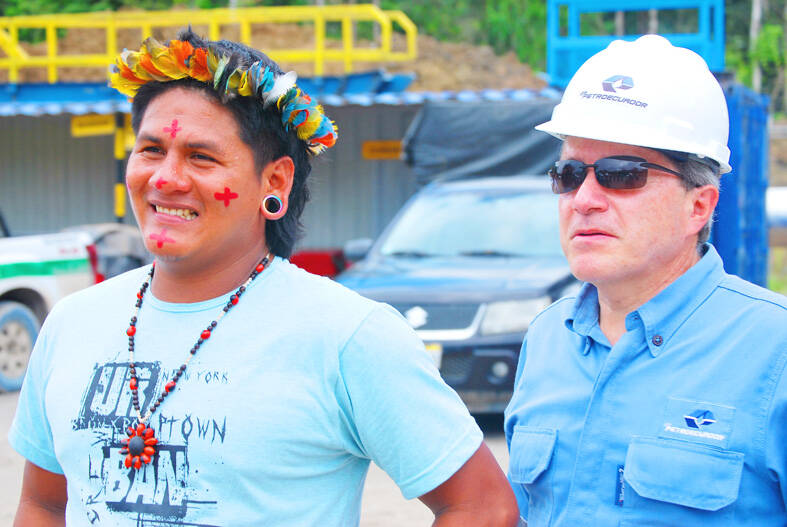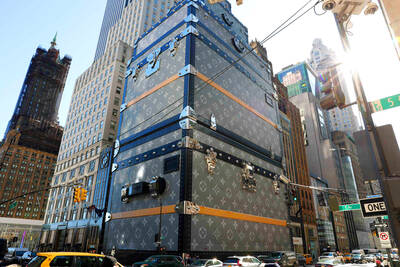A group of indigenous Waorani women give a war cry warning that environmentalists are not welcome in their part of the Ecuadoran Amazon, where an oil field operates partly on a protected reserve.
“We will not allow kowori [strangers] ... to enter,” said Waorani leader Felipe Ima, translating the belligerent words of a group of seven women from the Kawymeno community that supports oil extraction at the nearby Ishpingo field.
The community is pitted in a battle of wills against environmental group Yasunidos, which has been fighting for a decade for a referendum on leaving the oil underground.

Photo: EPA-EFE
In May, the Ecuadoran Constitutional Court allowed the request, and a plebiscite has been scheduled for next month.
Escorted by a warrior wielding a spear, the women from Kawymeno hold hands and dance in little clothing and feather crowns at the entrance to Ishpingo A platform.
They demand that any consultation should be with “the owners” of the land, and not with anyone that is “not even from the territory,” Ima said.
In Ecuador, the constitution recognizes indigenous people’s “collective ownership of land as an ancestral form of territorial organization.”
However, the state maintains control over anything under the soil. Ishpingo, together with the nearby fields of Tiputini and Tambococha, form the so-called ITT block, or block 43, which holds an estimated 282 million of the South American country’s proven crude reserves of 1.2 billion barrels.
Extraction at Tiputini and Tambococha started in 2016 after years of fraught debate over whether to drill inside the Yasuni National Park. This came after the government of then-Ecuadoran president Rafael Correa failed to persuade the international community to pay former OPEC member Ecuador US$3.6 billion not to exploit the ITT block to protect the Amazon and help curb climate change.
In April last year, the government announced pumping had also started at Ishpingo.
At the site protected by women in the dense, green jungle, stands one of 12 platforms of the ITT block that contributed 57,000 barrels per day to Ecuador’s total production of 464,000 barrels per day from January to April.
It is in the Yasuni National Park, a biosphere reserve that houses about 2,000 tree, 610 bird, 204 mammal, 150 amphibian and more than 120 reptile species, the San Francisco University of Quito said.
The Waorani community of Kawymeno, a journey of about four hours by foot and canoe from Ishpingo, is near the border with Peru.
Its 400 inhabitants have declared themselves defenders of the oil activity and its windfalls they say make up for the absence of government services.
“If there were no oil industry, we would not ... have had education, health, family welfare,” said Panenky Huabe, leader of the village where many work in the oil sector.
Aside from being among the most biodiverse areas on Earth, the 1 million hectare Yasuni park is home to two of the world’s last uncontacted indigenous populations. It also holds oil fields that started operating before the ITT block.
“We see how extraction has been besieging the Yasuni for many years, since the 1970s when exploitation began,” Yasunidos lawyer and spokesman Pedro Bermeo said.
“Basically, the [block] 43 is the only one with a part [of jungle] that remains to be saved,” he said.
However, the referendum has generated deep divisions even among the Waorani, whose 4,800 members own about 800,000 hectares of jungle in the provinces of Orellana, Pastaza and Napo.
In 2019, the Waorani of Pastaza won a historic court ruling that prevents the entry of oil companies on 180,000 hectares on their territory, but at Ishpingo A in Orellana, oil worker Akao Yetebe — also a Waorani — said “we will continue working,” because “black gold benefits big cities, teachers, education, health, everything.”
State-owned EP Petroecuador is authorized to operate on about 300 hectares of the Yasuni for its ITT block. So far it has used about 80 hectares, generating US$4.2 billion for the state — about US$1.2 billion last year alone.
If the “yes” wins in next month’s referendum, “losses will be substantial” — about US$16.4 billion in projected income, as well as jobs and investments already made, Petroecuador manager Ramon Correa said.

TAKING STOCK: A Taiwanese cookware firm in Vietnam urged customers to assess inventory or place orders early so shipments can reach the US while tariffs are paused Taiwanese businesses in Vietnam are exploring alternatives after the White House imposed a 46 percent import duty on Vietnamese goods, following US President Donald Trump’s announcement of “reciprocal” tariffs on the US’ trading partners. Lo Shih-liang (羅世良), chairman of Brico Industry Co (裕茂工業), a Taiwanese company that manufactures cast iron cookware and stove components in Vietnam, said that more than 40 percent of his business was tied to the US market, describing the constant US policy shifts as an emotional roller coaster. “I work during the day and stay up all night watching the news. I’ve been following US news until 3am

UNCERTAINTY: Innolux activated a stringent supply chain management mechanism, as it did during the COVID-19 pandemic, to ensure optimal inventory levels for customers Flat-panel display makers AUO Corp (友達) and Innolux Corp (群創) yesterday said that about 12 to 20 percent of their display business is at risk of potential US tariffs and that they would relocate production or shipment destinations to mitigate the levies’ effects. US tariffs would have a direct impact of US$200 million on AUO’s revenue, company chairman Paul Peng (彭雙浪) told reporters on the sidelines of the Touch Taiwan trade show in Taipei yesterday. That would make up about 12 percent of the company’s overall revenue. To cope with the tariff uncertainty, AUO plans to allocate its production to manufacturing facilities in

Six years ago, LVMH’s billionaire CEO Bernard Arnault and US President Donald Trump cut the blue ribbon on a factory in rural Texas that would make designer handbags for Louis Vuitton, one of the world’s best-known luxury brands. However, since the high-profile opening, the factory has faced a host of problems limiting production, 11 former Louis Vuitton employees said. The site has consistently ranked among the worst-performing for Louis Vuitton globally, “significantly” underperforming other facilities, said three former Louis Vuitton workers and a senior industry source, who cited internal rankings shared with staff. The plant’s problems — which have not

TARIFF CONCERNS: The chipmaker cited global uncertainty from US tariffs and a weakening economic outlook, but said its Singapore expansion remains on track Vanguard International Semiconductor Corp (世界先進), a foundry service provider specializing in producing power management and display driver chips, yesterday withdrew its full-year revenue projection of moderate growth for this year, as escalating US tariff tensions raised uncertainty and concern about a potential economic recession. The Hsinchu-based chipmaker in February said revenues this year would grow mildly from last year based on improving supply chain inventory levels and market demand. At the time, it also anticipated gradual quarter revenue growth. However, the US’ sweeping tariff policy has upended the industry’s supply chains and weakened economic prospects for the world economy, it said. “Now